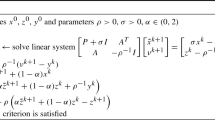Abstract
A parallel inexact Newton method with a line search is proposed for two-stage quadratic stochastic programs with recourse. A lattice rule is used for the numerical evaluation of multi-dimensional integrals, and a parallel iterative method is used to solve the quadratic programming subproblems. Although the objective only has a locally Lipschitz gradient, global convergence and local superlinear convergence of the method are established. Furthermore, the method provides an error estimate which does not require much extra computation. The performance of the method is illustrated on a CM5 parallel computer.
Similar content being viewed by others
References
D.P. Bertsekas and J.N. Tsitsiklis,Parallel and Distributed Computation: Numerical Methods, Prentice-Hall, New Jersey, 1989.
D.P. Bertsekas,Constrained Optimization and Lagrange Multiplier Methods, Academic Press, New York, 1982.
J.R. Birge and R.J-B Wets, Designing approximation schemes for stochastic optimization problems, in particular, for stochastic programs with recourse, Mathematical Programming Study 27, 1986, 54–102.
J.R. Birge, X. Chen and L. Qi, A stochastic Newton method for stochastic quadratic programs with recourse, Applied Mathematics Preprint AM94/9, School of Mathematics, University of New South Wales, Sydney, Australia, 1994.
X. Chen, L. Qi and R.S. Womersley, Newton's method for quadratic stochastic programs with recourse, Journal of Computational and Applied Mathematics 60, 1995, 29–46.
F.H. Clarke,Optimization and Nonsmooth Analysis, Wiley, New York, 1983.
P.J. Davis and P. Rabinowitz,Methods of Numerical Integration, 2nd ed., Academic Press, New York, 1984.
R.S. Dembo, S.C. Eisenstat and T. Steihaug, Inexact Newton methods, SIAM Journal on Numerical Analysis 19, 1982, 400–408.
R.S. Dembo and U. Tulowitzki, Sequential truncated quadratic programming methods, inNumerical Optimization, P.T. Boggs, R.H. Byrd and R.B. Schnabel, eds., 1984, SIAM, Philadelphia, 1985, pp. 83–101.
M.C. Ferris and O.L. Mangasarian, Parallel constraint distribution, SIAM Journal on Optimization 1, 1991, 487–500.
R. Fletcher,Practical Methods of Optimization, 2nd ed., Wiley, Chichester/New York, 1987.
S.A. Gabriel and J.S. Pang, An inexact NE/SQP method for solving the nonlinear complementarity problem, Computational Optimization and Applications 1, 1992, 67–91.
U.C. Garcia Palomares and O.L. Mangasarian, Superlinear convergent quasi-Newton algorithms for nonlinearly constrained optimization problems, Mathematical Programming 11, 1976, 1–13.
J.L. Higle and S. Sen, Stochastic decomposition: an algorithm for two-stage linear programs with recourse, Mathematics of Operations Research 16, 1991, 650–669.
A.N. Iusem and A.R. De Pierro, On the convergence of Han's method for convex programming with quadratic objective, Mathematical Programming 52, 1991, 265–284.
S. Joe and I.H. Sloan, Imbedded lattice rules for multidimensional integration, SIAM Journal on Numerical Analysis 29, 1992, 1119–1135.
S. Joe and I. H. Sloan, Implementation of a lattice method for numerical multiple integration, ACM Transactions on Mathematical Software 19, 1993, 523–545.
P. Kall, Stochastic programming — an introduction, in6th International Conference on Stochastic Programming, Italy, 1992.
P. Kall and S.W. Wallace,Stochastic Programming, Wiley, Chichester/New York, 1994.
Y.M. Kaniovski, A.J. King and R.J-B Wets, Probabilistic bounds (via large deviations) for the solutions of stochastic programming problems, Preprint, 1993.
H. Niederreiter,Random Number Generation and Quasi-Monte Carlo Methods, Society for Industrial and Applied Mathematics, Philadelphia, PA, 1992.
J.S. Pang, Inexact Newton methods for the nonlinear complementarity problem, Mathematical Programming 36, 1986, 54–71.
J.S. Pang, Newton's method forB-differentiable equations, Mathematics of Operations Research 15, 1990, 311–341.
J.S. Pang and L. Qi, A globally convergent Newton method for convexSC 1 minimization problems, Journal of Optimization Theory and Applications 85, 1995, 633–648.
L. Qi, Convergence analysis of some algorithms for solving nonsmooth equations, Mathematics of Operations Research 18, 1993, 227–244.
L. Qi, Superlinear convergent approximate Newton methods forLC 1 optimization problems, Mathematical Programming 64, 1994, 277–294.
L. Qi and J. Sun, A nonsmooth version of Newton's method, Mathematical Programming 58, 1993, 353–367.
L. Qi and R.S. Womersley, An SQP algorithm for extended linear-quadratic problems in stochastic programming, Annals of Operations Research 56, 1995, 251–285.
R. T. Rockafellar,Convex Analysis, Princeton University Press, Princeton, NJ, 1970.
R. T. Rockafellar and R.J-B Wets, A dual solution procedure for quadratic stochastic programs with simple recourse, inNumerical Methods, V. Pereyra and A. Reinoza, eds., Lecture Notes in Mathematics 1005, Springer, Berlin, 1983, pp. 252–265.
R.T. Rockafellar and R.J-B Wets, A Lagrangian finite-generation technique for solving linear-quadratic problems in stochastic programming, Mathematical Programming Study 28, 1986, 63–93.
R.T. Rockafellar and R.J-B Wets, Linear-quadratic problems with stochastic penalties: The finite generation algorithm, inStochastic Optimization, V.I. Arkin, A. Shiraev and R.J-B Wets, eds., Lecture Notes in Control and Information Sciences 81, Springer, Berlin, 1987, pp. 545–560.
S.M. Robinson, Perturbed Kuhn-Tucker points and rates of convergence for a class of nonlinear programming algorithms, Mathematical Programming 7, 1974, 1–16.
S.M. Robinson, An implicit-function theorem for a class of nonsmooth equations, Mathematics of Operations Research 16, 1991, 292–309.
A. Ruszczynski, Parallel decomposition of multistage stochastic programming problems, Mathematical Programming 58, 1993, 201–228.
I.H. Sloan and S. Joe,Lattice Methods for Multiple Integration, Clarendon Press, Oxford, 1994.
P. Tseng, Applications of a splitting algorithm to decomposition in convex programming and variation inequalities, SIAM Journal on Control and Optimization 29, 1991, 119–138.
S.W. Wallace, A two-stage stochastic facility location problem with time-dependent supply, inNumerical Techniques for Stochastic Optimization, Y. Ermoliev and R.J-B Wets, eds., Springer, Berlin/New York, 1988, pp. 65–93.
C. Zhu and R.T. Rockafellar, Primal-dual projected gradient algorithms for extended linear-quadratic programming, SIAM Journal on Optimization 3, 1993, 751–783.
Author information
Authors and Affiliations
Additional information
This work was supported by the Australian Research Council and the numerical experiments were done on the Sydney Regional Centre for Parallel Computing CM5.
Rights and permissions
About this article
Cite this article
Chen, X., Womersley, R.S. A parallel inexact newton method for stochastic programs with recourse. Ann Oper Res 64, 113–141 (1996). https://doi.org/10.1007/BF02187643
Issue Date:
DOI: https://doi.org/10.1007/BF02187643




